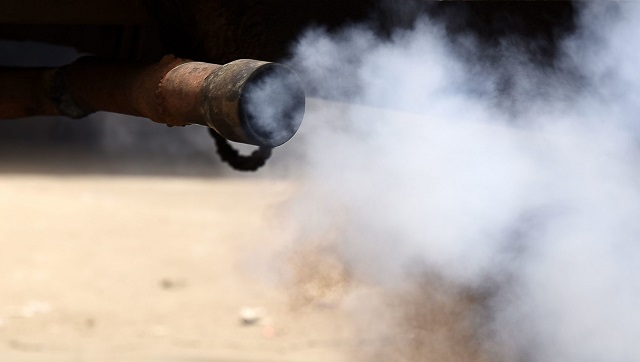
By Okeya John
A new study conducted in Kampala has confirmed that timely maintenance of car engines could significantly reduce emissions and offer a crucial pathway towards improving our capital city’s troubling air quality trends in Uganda.
Led by Makerere University’s Prof. Lynn Atuyambe, the groundbreaking study reports that long-term exposure to particulate matter—the tiny droplets of dust, dirt, soot, and smoke in the air that can be inhaled and cause health problems—resulted in at least 7,257 air pollution-related deaths in Kampala alone between 2018 and 2021, urging for a “clear need” to improve air quality control in Kampala and the other mushrooming cities within the country.
“We would like to warn that we have a real problem,” Prof. Atuyambe emphasised with great concern while discussing the study's findings with MakSPH’s John Okeya. He further revealed, “I have just presented the results to the National Communicable and Non-Communicable Diseases Technical Working Group of the Ministry of Health. They were surprised but it’s true. So, as citizens, I would like to warn and advise that we should reduce and mitigate air pollution”
Prof. Atuyambe is the Principal Investigator of the study, entitled: Air quality and attributable mortality among city dwellers in Kampala, Uganda: results from 4 years of continuous PM2.5 concentration monitoring using BAM 1022 reference instrument, recently published in the Hhigh Iimpact Journal of Exposure Science & Environmental Epidemiology in June 2024.
Alongside colleagues Mr. Samuel Etajak, Mr. Felix Walyawula, Dr. Simon Kasasa, Ms. Agnes Nyabigambo, and Prof. William Bazeyo from MakSPH, as well as Prof. Heather Wipfli from the University of Southern California Keck School of Medicine, Prof. Jonathan Samet, the Dean of Colorado School of Public Health, and Prof. Kiros Berhane, the Chair of Biostatistics at Columbia Mailman School of Public Health, Prof. Atuyambe investigated the estimates of air pollution-attributable mortality in Kampala city, focusing on ambient fine particulate matter
The researchers used the World Health Organisation (WHO) AirQ+ software to quantify the health burden and impact of air pollution, calculating attributable risk estimates for mortality in Kampala by employing a time series design with daily data on ambient particulate matter concentration levels obtained from a Beta Attenuation Monitor (BAM-1022) machine mounted on top of the Makerere University School of Public Health ( MakSPH) building in Mulago, along with all-cause mortality data from the Uganda Bureau of Statistics and the Ministry of Health.
“We have been monitoring Kampala’s air quality for some time now. Up to date, we are still monitoring. It is a reference monitor (BAM-1022), so it is a gold standard machine that is Environmental Protection Agency (EPA) certified, which gives the true value for air pollution. When you consider the World Health Organisation guidelines, Kampala is very much polluted and we are eight times above the recommended standard,” Prof. Atuyambe intimated.
Their study’s results revealed alarming statistics for Kampala city. Over the four years of analysis from 2018 to 2021, the annual average concentration of inhalable harmful particulate matter (PM2.5)—the tiny droplets of dust, dirt, soot, and smoke suspended in the air—hovering over Kampala’s 1.88 million residents and an additional 627,340 estimated daily visitors, was found to be standing at a staggering 39 micrograms per cubic meter high, a measure eight times above the WHO recommended limit of five micrograms per cubic meter.
What this means, is that the increased levels of exposure to the polluted air leads to serious health issues for the population - particularly for infants, the elderly, and people with preexisting health conditions - from respiratory to cardiovascular diseases; including asthma, bronchitis, heart disease, stroke, and also, premature deaths, posing a severe public health risk.
Based on their observation, particulate matter concentration varied across seasons and hours of the day, with a tendency to lower during the rainy months of March to June and October to December and peak daily in the morning (around 9:00 am when people are likely moving to work) - due to increased vehicular emissions, and in the night (around 11:00 pm when industries are likely active due to lower electricity tariffs at night) due to increased factory activity. Across four years of monitoring, Saturdays recorded the highest pollution levels, averaging 41.2 micrograms per cubic meter compared to the annual average of 39.
In Kampala, the dry seasons are associated with higher dust levels coming from unpaved roads, construction sites, and the burning of biomass and plastics, with this combustion mix partially contributing to the “corresponding high pollution levels”. The study also observes that the daily peaks in pollution correspond to the times when most vehicles are on the road, pointing to the substantial contribution made by vehicle exhaust and non-exhaust emissions, mainly emanating from brakes, tyre wear, and road dust from heavy traffic and unpaved roadways.
“Our study is the first to estimate air pollution attributable deaths in Kampala city considering the target as the WHO annual guideline value for PM2.5 of 5 μg/m3. Our monitoring data show that fine particulate matter air pollution in Kampala exceeds the WHO Air Quality Guideline value, likely resulting in substantial adverse health effects and premature death.” The study report reads in part, showing that the health impacts of air pollution in Kampala are stark.
Long-term exposure to the dangerous particulate matter is confirmed in the study to be responsible for at least 7,257 air pollution-related deaths in Kampala, with specific mortalities of 2,777 deaths (19.3 per cent) recorded in 2018, 2,136 (17.9 per cent) in 2019, 1,281 deaths (17.9 per cent) in 2020, and 1,063 (19.8 per cent) in 2021, all attributable to air pollution.
For Prof. Atuyambe, over the past two years, there has been a significant leap in air pollution across the globe, and not just in Kampala. Consequently, air pollution is now listed as the second-largest risk factor for death in the 2024 State of Global Air (SoGA) report, a collaborative initiative by the Health Effects Institute (HEI) and the Institute for Health Metrics and Evaluation (IHME) with support from UNICEF, providing authentic comprehensive estimates of air quality and health trends worldwide.
This new ranking is only bettered by high blood pressure as the primary global risk factor for deaths. The other cause factors include tobacco use, poor diet, and high fasting plasma glucose, in their order of listing. In 2021, SoGA shows that air pollution caused 8.1 million deaths globally, 58 per cent of these coming from the fatal ambient particulate matter (PM2.5), which was investigated in the study in Kampala. The other 38 per cent came from household air pollution, and 6 per cent from ozone (O₃). What’s more, 709,000 of the deaths were of children under the age of five, with the adverse impacts disproportionately affecting Asia and Africa.
In their study, the researchers observe that while further monitoring is necessary, control measures should be taken to mitigate risk and improve air quality. Around the world, Kampala ranks poorly in the quality of air we breathe. At the time of writing this news article, Kampala was the 15th most polluted major city worldwide, according to the US-based IQAir real-time air quality information platform, classified as "unhealthy for sensitive groups," due to high-level concentrates of particulate matter (PM2.5) in the city, coming mainly from car emissions.
Although information remains scanty, Uganda has approximately 2.7 million registered vehicles, including cars, trucks, and motorcycles. Many of these vehicles are over 15 years old, contributing significantly to air pollution due to their inefficient engines and lack of modern emission control technologies. Poor maintenance of these vehicles further exacerbates the problem, leading to higher emissions of particulate matter and other pollutants into the air.
“Air pollution due to motor vehicle emissions is a challenge, especially in low and middle-income countries (like Uganda) where urban populations are growing rapidly, fuel quality is poor, and vehicles are older and irregularly maintained,” Prof. Atuyambe and colleagues opine in their study report. Adding that;
“Our results emphasise the urgent need to establish and strengthen policies aimed at reducing vehicle pollution, including better enforcement of vehicle emission standards, improvements in public transportation and investment in electric vehicles.”
To them, a system for enforcement and monitoring of regular vehicular servicing and repairs should be developed in collaboration with motor vehicle servicing centres and fuel stations. Such a move, they argue, would empower relevant governmental bodies such as the Ministry of Works and Transport and the Uganda Police Force to enforce standards, given that regular and timely maintenance of car engines significantly reduces emissions and improves air quality.
A quick internet search reveals that regular car servicing is crucial for maintaining optimal vehicle performance and reducing emissions that contribute to air pollution. Generally, car manufacturers recommend servicing a vehicle once a year or after every 12,000 kilometres of driving, although this can vary, based on the car's age, mileage, and type.
The search also shows that new cars require an initial check after 1,000 kilometres, while those with lower mileage might need servicing every six months. Specific components also have different maintenance schedules; for instance, oil and oil filters should be changed every 5,000 kilometres, transmission and steering fluids checked or renewed every 40,000 kilometres, and engine coolant fluid replaced every two years. The type of vehicle also matters. Toyota recommends servicing their cars every 5,000 miles or six months, whichever comes first.
Prof. Atuyambe cogently holds that adhering to car maintenance guidelines can ensure vehicles run efficiently, thereby reducing their environmental impact by minimising harmful emissions. In Uganda, compliance with these servicing schedules remains a challenge. However, it represents a crucial step towards addressing dire air quality and persistent road cratches.
Lynn M. Atuyambe is an Assoc. Professor at Makerere University School of Public Health and the Lead for the GEOHealth-Hub, Uganda project. The Hub partners with universities in the U.S., Ethiopia, Kenya, and Rwanda to address global air quality monitoring and lung health research.
Please find the scientific research paper here.

